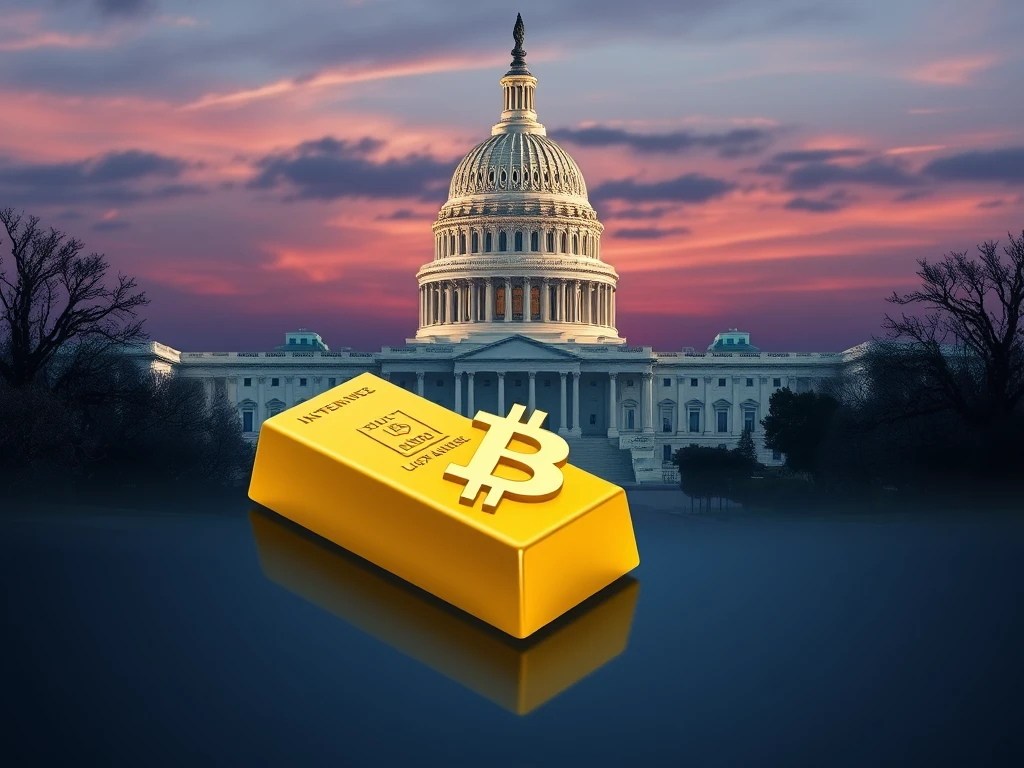Strategic Play: US Gov’t Eyes Smart Gold Move to Boost Bitcoin Reserve

In a fascinating turn of events, the Trump administration is exploring innovative, budget-neutral strategies to significantly expand its Strategic Bitcoin Reserve. Imagine a scenario where the government could increase its Bitcoin holdings without costing taxpayers a single dime. This isn’t just wishful thinking; it’s a tangible possibility being discussed at the highest levels, spearheaded by the President’s Council of Advisers on Digital Assets. Bo Hines, the council’s executive director, recently hinted at ‘creative ideas’ to acquire more Bitcoin, and one particularly intriguing proposal involves realizing the untapped value of government-held gold certificates.
Unlocking Bitcoin Gains with Gold Certificates: A Smart Financial Strategy?
What if the key to bolstering the nation’s strategic reserve of digital assets lies buried in the government’s vaults, not as physical gold, but as gold certificates? Bo Hines, in a recent interview, pointed towards Senator Cynthia Lummis’ Bitcoin Act of 2025 as a potential roadmap. This act suggests a clever mechanism: reassessing the value of gold certificates, which are currently priced far below the actual market value of gold.
Think of it this way: these certificates are essentially claims on gold, but they are valued at a statutory price of just $42.22 per troy ounce, a figure drastically lower than today’s spot gold price, which exceeds $3,000 an ounce! This massive discrepancy represents a potential unrealized gain for the government.
By updating the valuation of these certificates to reflect current market prices, the government could ‘realize gains’ – essentially, unlock this hidden value. According to Hines, this approach could be “budget-neutral,” meaning it wouldn’t require new taxpayer funds. It’s about making existing assets work smarter to acquire new, strategic assets like Bitcoin.
How Would This Work? Decoding the Gold Certificate Strategy
Senator Lummis’ BITCOIN Act of 2025 provides a detailed framework. It proposes that Federal Reserve banks should return all gold certificates in their possession to the Treasury Secretary. The Secretary would then issue new certificates that accurately reflect the current, much higher, market value of the gold backing them.
This revaluation creates a budgetary space – the ‘gains’ – which could then be strategically deployed. Hines emphasized that the crypto council is open to any ideas that are “budget-neutral” and don’t burden taxpayers. This aligns perfectly with President Trump’s executive order, which seeks innovative, cost-effective ways to build the nation’s digital asset holdings.
The beauty of this strategy lies in its ingenuity. It’s not about spending more; it’s about optimizing existing government assets to invest in the future of finance. With numerous agencies involved in these discussions, Hines anticipates a wealth of “tremendous ideas” to emerge, all focused on strategically growing the US government Bitcoin holdings.
America’s Growing Bitcoin Stockpile: A Strategic Advantage?
Currently, the US government is already a significant player in the Bitcoin world, holding approximately 207,000 BTC. This substantial amount, primarily seized from criminal activities, positions the United States as the largest known national holder of Bitcoin.
Adding to this stockpile through budget-neutral strategies like leveraging gold certificates could further solidify America’s position in the digital asset space. It’s a move that could be interpreted as a forward-thinking approach to national financial strategy, recognizing the growing importance of cryptocurrencies in the global economy.
Bitcoin’s Special Status: Why is the White House Treating Bitcoin Differently?
During his interview, Hines underscored the unique position of Bitcoin within the broader digital asset landscape. He highlighted that the White House crypto council is deliberately differentiating between the Strategic Bitcoin Reserve and a general digital asset stockpile, which might include various altcoins.
“The reason we structured the [Strategic Bitcoin Reserve] the way we did is because Bitcoin is different. It’s unique; it’s a commodity, not a security,” Hines explained. He echoed sentiments from figures like David Sacks, who describe Bitcoin as having an “immaculate conception” – meaning it’s decentralized, with no issuer, possessing intrinsic stored value and acting as a traditional store of value.
This distinct categorization signals a profound understanding within the administration of Bitcoin’s fundamental properties and its potential role in a national strategic reserve. It’s not just another cryptocurrency; it’s being viewed as a distinct asset class with unique characteristics deserving of special consideration.
Beyond Bitcoin: A Broader Crypto Strategy Taking Shape
While the focus on Bitcoin is clear, the Trump administration’s crypto strategy extends beyond just this flagship cryptocurrency. There’s significant bipartisan momentum building in Congress towards comprehensive cryptocurrency legislation.
Representative Ro Khanna, a Democrat from California, believes that a stablecoin bill and a broader crypto market structure bill are likely to pass Congress this year. This bipartisan cooperation suggests a growing consensus on the need for clear regulatory frameworks to support the responsible growth of the cryptocurrency industry in the United States.
The Road Ahead: What Does This Mean for Bitcoin and the US?
The potential move to utilize gains from gold certificates to acquire more Bitcoin is a bold and innovative strategy. It demonstrates a willingness within the US government to explore unconventional financial mechanisms to strengthen its position in the digital age.
If successful, this approach could not only increase the nation’s strategic reserve of Bitcoin without burdening taxpayers but also set a precedent for other governments to consider similar creative financial strategies. It signals a growing recognition of Bitcoin’s strategic importance and the need for governments to engage proactively with the evolving landscape of digital assets. Keep watching this space – the future of government Bitcoin holdings and the broader US crypto strategy is unfolding rapidly.








